Copyright
Table of Contents
Preface
The Machine Learning Tsunami
Machine Learning in Your Projects
Objective and Approach
Prerequisites
Roadmap
Other Resources
Conventions Used in This Book
Using Code Examples
O’Reilly Safari
How to Contact Us
Acknowledgments
Part I. The Fundamentals of Machine Learning
Chapter 1. The Machine Learning Landscape
What Is Machine Learning?
Why Use Machine Learning?
Types of Machine Learning Systems
Supervised/Unsupervised Learning
Batch and Online Learning
Instance-Based Versus Model-Based Learning
Main Challenges of Machine Learning
Insufficient Quantity of Training Data
Nonrepresentative Training Data
Poor-Quality Data
Irrelevant Features
Overfitting the Training Data
Underfitting the Training Data
Stepping Back
Testing and Validating
Exercises
Chapter 2. End-to-End Machine Learning Project
Working with Real Data
Look at the Big Picture
Frame the Problem
Select a Performance Measure
Check the Assumptions
Get the Data
Create the Workspace
Download the Data
Take a Quick Look at the Data Structure
Create a Test Set
Discover and Visualize the Data to Gain Insights
Visualizing Geographical Data
Looking for Correlations
Experimenting with Attribute Combinations
Prepare the Data for Machine Learning Algorithms
Data Cleaning
Handling Text and Categorical Attributes
Custom Transformers
Feature Scaling
Transformation Pipelines
Select and Train a Model
Training and Evaluating on the Training Set
Better Evaluation Using Cross-Validation
Fine-Tune Your Model
Grid Search
Randomized Search
Ensemble Methods
Analyze the Best Models and Their Errors
Evaluate Your System on the Test Set
Launch, Monitor, and Maintain Your System
Try It Out!
Exercises
Chapter 3. Classification
MNIST
Training a Binary Classifier
Performance Measures
Measuring Accuracy Using Cross-Validation
Confusion Matrix
Precision and Recall
Precision/Recall Tradeoff
The ROC Curve
Multiclass Classification
Error Analysis
Multilabel Classification
Multioutput Classification
Exercises
Chapter 4. Training Models
Linear Regression
The Normal Equation
Computational Complexity
Gradient Descent
Batch Gradient Descent
Stochastic Gradient Descent
Mini-batch Gradient Descent
Polynomial Regression
Learning Curves
Regularized Linear Models
Ridge Regression
Lasso Regression
Elastic Net
Early Stopping
Logistic Regression
Estimating Probabilities
Training and Cost Function
Decision Boundaries
Softmax Regression
Exercises
Chapter 5. Support Vector Machines
Linear SVM Classification
Soft Margin Classification
Nonlinear SVM Classification
Polynomial Kernel
Adding Similarity Features
Gaussian RBF Kernel
Computational Complexity
SVM Regression
Under the Hood
Decision Function and Predictions
Training Objective
Quadratic Programming
The Dual Problem
Kernelized SVM
Online SVMs
Exercises
Chapter 6. Decision Trees
Training and Visualizing a Decision Tree
Making Predictions
Estimating Class Probabilities
The CART Training Algorithm
Computational Complexity
Gini Impurity or Entropy?
Regularization Hyperparameters
Regression
Instability
Exercises
Chapter 7. Ensemble Learning and Random Forests
Voting Classifiers
Bagging and Pasting
Bagging and Pasting in Scikit-Learn
Out-of-Bag Evaluation
Random Patches and Random Subspaces
Random Forests
Extra-Trees
Feature Importance
Boosting
AdaBoost
Gradient Boosting
Stacking
Exercises
Chapter 8. Dimensionality Reduction
The Curse of Dimensionality
Main Approaches for Dimensionality Reduction
Projection
Manifold Learning
PCA
Preserving the Variance
Principal Components
Projecting Down to d Dimensions
Using Scikit-Learn
Explained Variance Ratio
Choosing the Right Number of Dimensions
PCA for Compression
Incremental PCA
Randomized PCA
Kernel PCA
Selecting a Kernel and Tuning Hyperparameters
LLE
Other Dimensionality Reduction Techniques
Exercises
Part II. Neural Networks and Deep Learning
Chapter 9. Up and Running with TensorFlow
Installation
Creating Your First Graph and Running It in a Session
Managing Graphs
Lifecycle of a Node Value
Linear Regression with TensorFlow
Implementing Gradient Descent
Manually Computing the Gradients
Using autodiff
Using an Optimizer
Feeding Data to the Training Algorithm
Saving and Restoring Models
Visualizing the Graph and Training Curves Using TensorBoard
Name Scopes
Modularity
Sharing Variables
Exercises
Chapter 10. Introduction to Artificial Neural Networks
From Biological to Artificial Neurons
Biological Neurons
Logical Computations with Neurons
The Perceptron
Multi-Layer Perceptron and Backpropagation
Training an MLP with TensorFlow’s High-Level API
Training a DNN Using Plain TensorFlow
Construction Phase
Execution Phase
Using the Neural Network
Fine-Tuning Neural Network Hyperparameters
Number of Hidden Layers
Number of Neurons per Hidden Layer
Activation Functions
Exercises
Chapter 11. Training Deep Neural Nets
Vanishing/Exploding Gradients Problems
Xavier and He Initialization
Nonsaturating Activation Functions
Batch Normalization
Gradient Clipping
Reusing Pretrained Layers
Reusing a TensorFlow Model
Reusing Models from Other Frameworks
Freezing the Lower Layers
Caching the Frozen Layers
Tweaking, Dropping, or Replacing the Upper Layers
Model Zoos
Unsupervised Pretraining
Pretraining on an Auxiliary Task
Faster Optimizers
Momentum optimization
Nesterov Accelerated Gradient
AdaGrad
RMSProp
Adam Optimization
Learning Rate Scheduling
Avoiding Overfitting Through Regularization
Early Stopping
ℓ1 and ℓ2 Regularization
Dropout
Max-Norm Regularization
Data Augmentation
Practical Guidelines
Exercises
Chapter 12. Distributing TensorFlow Across Devices and Servers
Multiple Devices on a Single Machine
Installation
Managing the GPU RAM
Placing Operations on Devices
Parallel Execution
Control Dependencies
Multiple Devices Across Multiple Servers
Opening a Session
The Master and Worker Services
Pinning Operations Across Tasks
Sharding Variables Across Multiple Parameter Servers
Sharing State Across Sessions Using Resource Containers
Asynchronous Communication Using TensorFlow Queues
Loading Data Directly from the Graph
Parallelizing Neural Networks on a TensorFlow Cluster
One Neural Network per Device
In-Graph Versus Between-Graph Replication
Model Parallelism
Data Parallelism
Exercises
Chapter 13. Convolutional Neural Networks
The Architecture of the Visual Cortex
Convolutional Layer
Filters
Stacking Multiple Feature Maps
TensorFlow Implementation
Memory Requirements
Pooling Layer
CNN Architectures
LeNet-5
AlexNet
GoogLeNet
ResNet
Exercises
Chapter 14. Recurrent Neural Networks
Recurrent Neurons
Memory Cells
Input and Output Sequences
Basic RNNs in TensorFlow
Static Unrolling Through Time
Dynamic Unrolling Through Time
Handling Variable Length Input Sequences
Handling Variable-Length Output Sequences
Training RNNs
Training a Sequence Classifier
Training to Predict Time Series
Creative RNN
Deep RNNs
Distributing a Deep RNN Across Multiple GPUs
Applying Dropout
The Difficulty of Training over Many Time Steps
LSTM Cell
Peephole Connections
GRU Cell
Natural Language Processing
Word Embeddings
An Encoder–Decoder Network for Machine Translation
Exercises
Chapter 15. Autoencoders
Efficient Data Representations
Performing PCA with an Undercomplete Linear Autoencoder
Stacked Autoencoders
TensorFlow Implementation
Tying Weights
Training One Autoencoder at a Time
Visualizing the Reconstructions
Visualizing Features
Unsupervised Pretraining Using Stacked Autoencoders
Denoising Autoencoders
TensorFlow Implementation
Sparse Autoencoders
TensorFlow Implementation
Variational Autoencoders
Generating Digits
Other Autoencoders
Exercises
Chapter 16. Reinforcement Learning
Learning to Optimize Rewards
Policy Search
Introduction to OpenAI Gym
Neural Network Policies
Evaluating Actions: The Credit Assignment Problem
Policy Gradients
Markov Decision Processes
Temporal Difference Learning and Q-Learning
Exploration Policies
Approximate Q-Learning
Learning to Play Ms. Pac-Man Using Deep Q-Learning
Exercises
Thank You!
Appendix A. Exercise Solutions
Chapter 1: The Machine Learning Landscape
Chapter 2: End-to-End Machine Learning Project
Chapter 3: Classification
Chapter 4: Training Linear Models
Chapter 5: Support Vector Machines
Chapter 6: Decision Trees
Chapter 7: Ensemble Learning and Random Forests
Chapter 8: Dimensionality Reduction
Chapter 9: Up and Running with TensorFlow
Chapter 10: Introduction to Artificial Neural Networks
Chapter 11: Training Deep Neural Nets
Chapter 12: Distributing TensorFlow Across Devices and Servers
Chapter 13: Convolutional Neural Networks
Chapter 14: Recurrent Neural Networks
Chapter 15: Autoencoders
Chapter 16: Reinforcement Learning
Appendix B. Machine Learning Project Checklist
Frame the Problem and Look at the Big Picture
Get the Data
Explore the Data
Prepare the Data
Short-List Promising Models
Fine-Tune the System
Present Your Solution
Launch!
Appendix C. SVM Dual Problem
Appendix D. Autodiff
Manual Differentiation
Symbolic Differentiation
Numerical Differentiation
Forward-Mode Autodiff
Reverse-Mode Autodiff
Appendix E. Other Popular ANN Architectures
Hopfield Networks
Boltzmann Machines
Restricted Boltzmann Machines
Deep Belief Nets
Self-Organizing Maps
Index
About the Author
Colophon
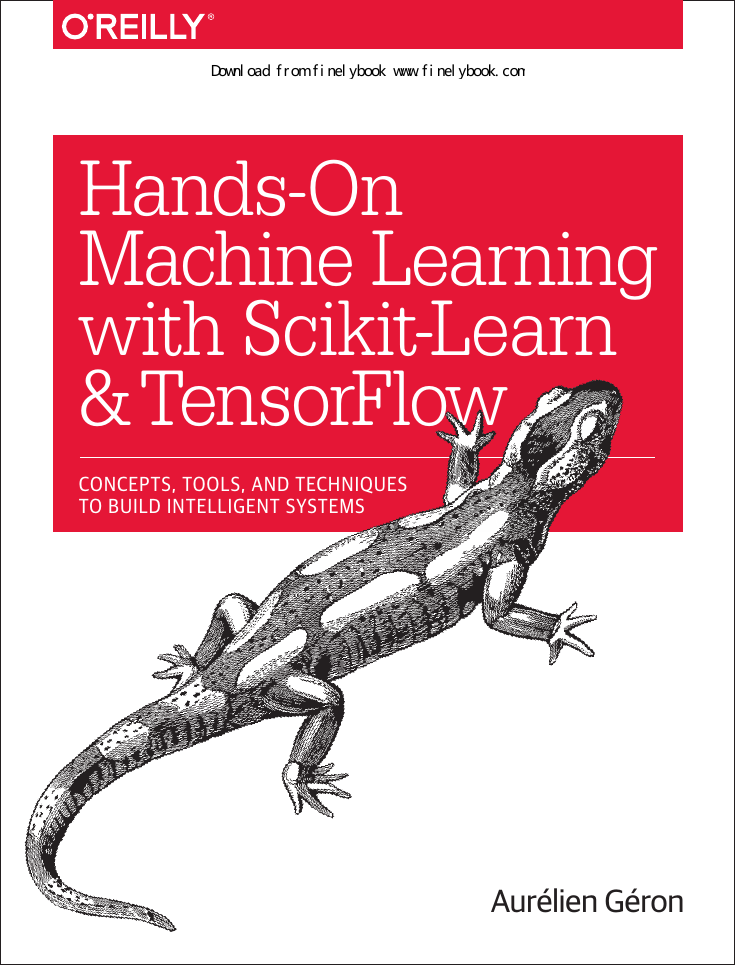
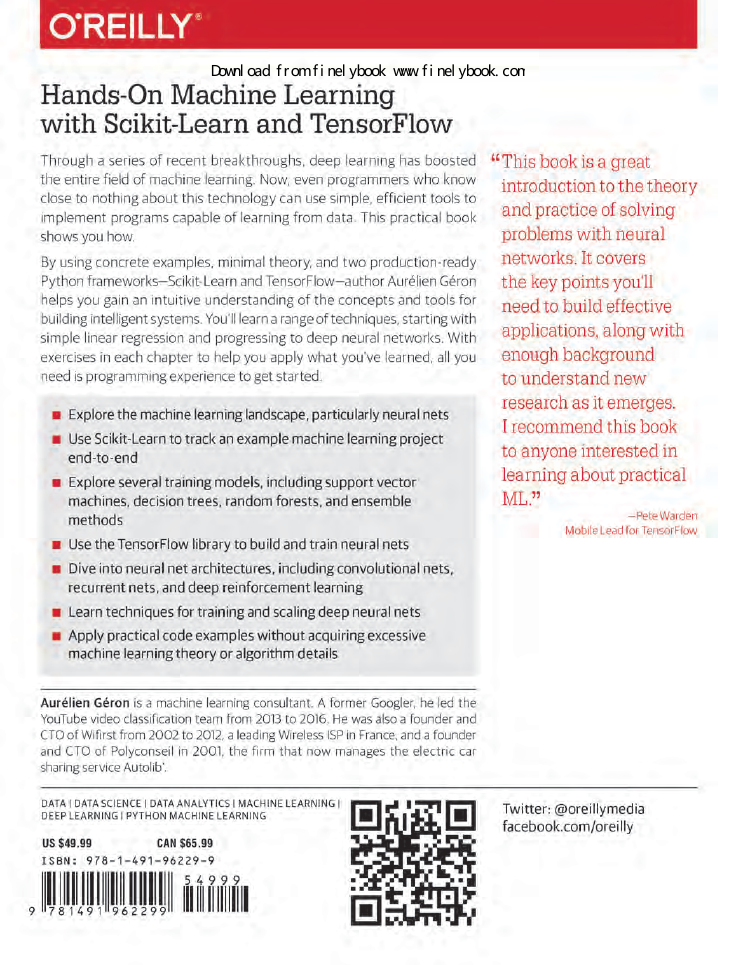
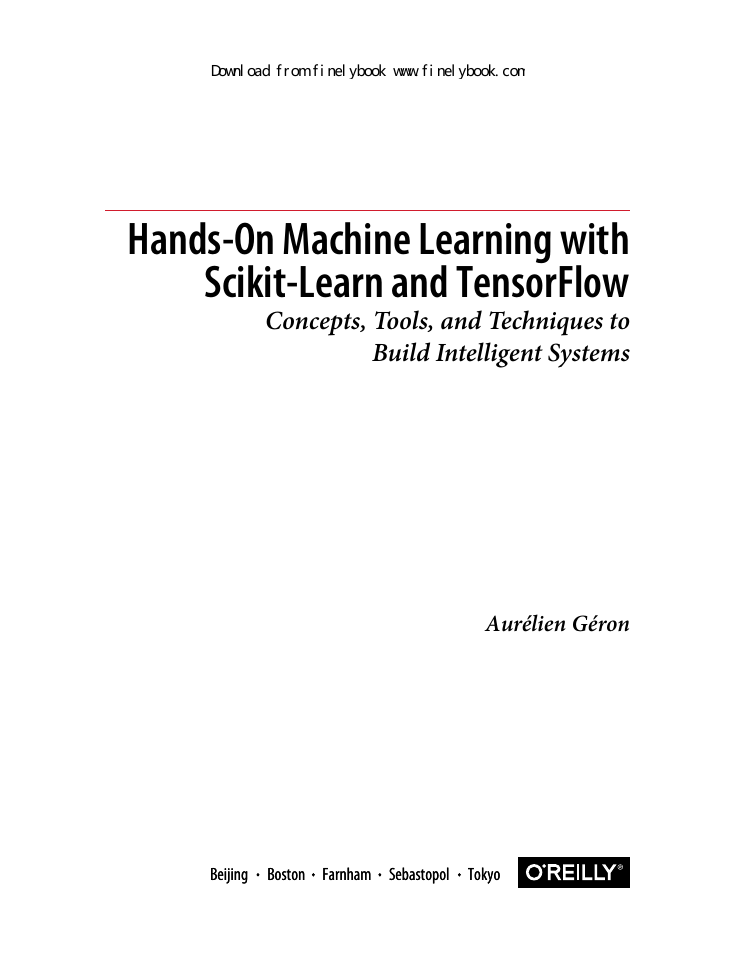
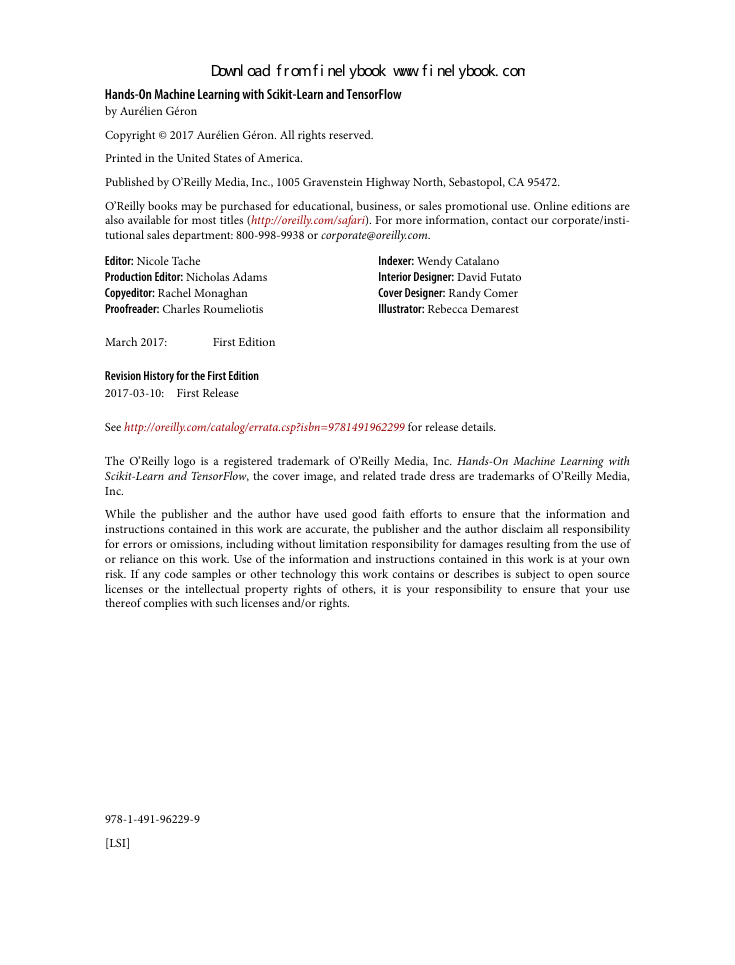
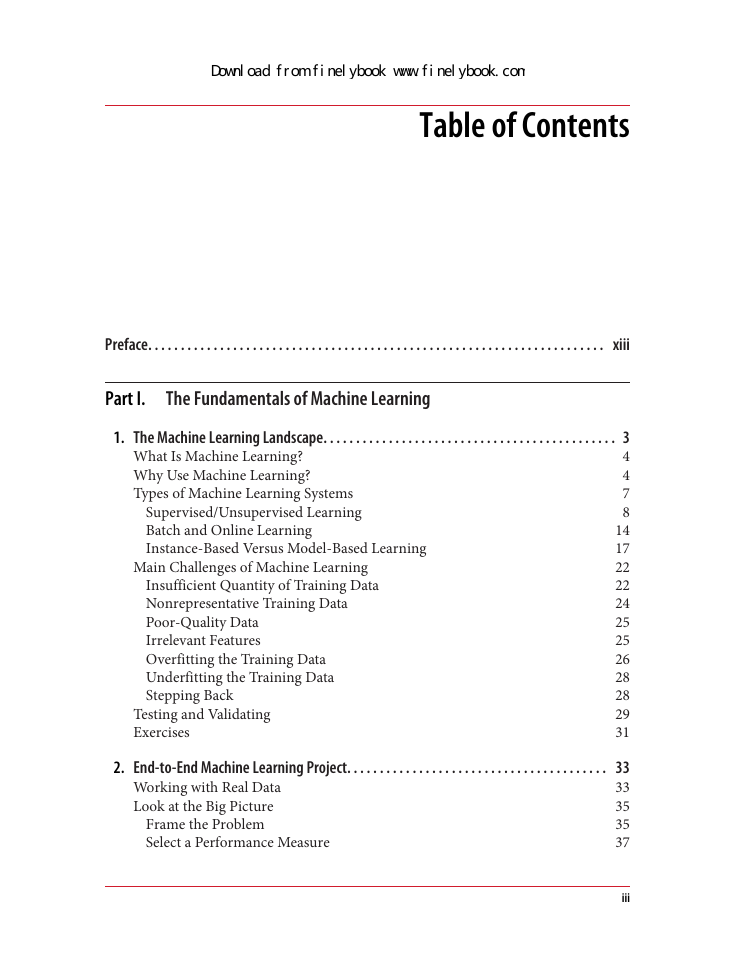

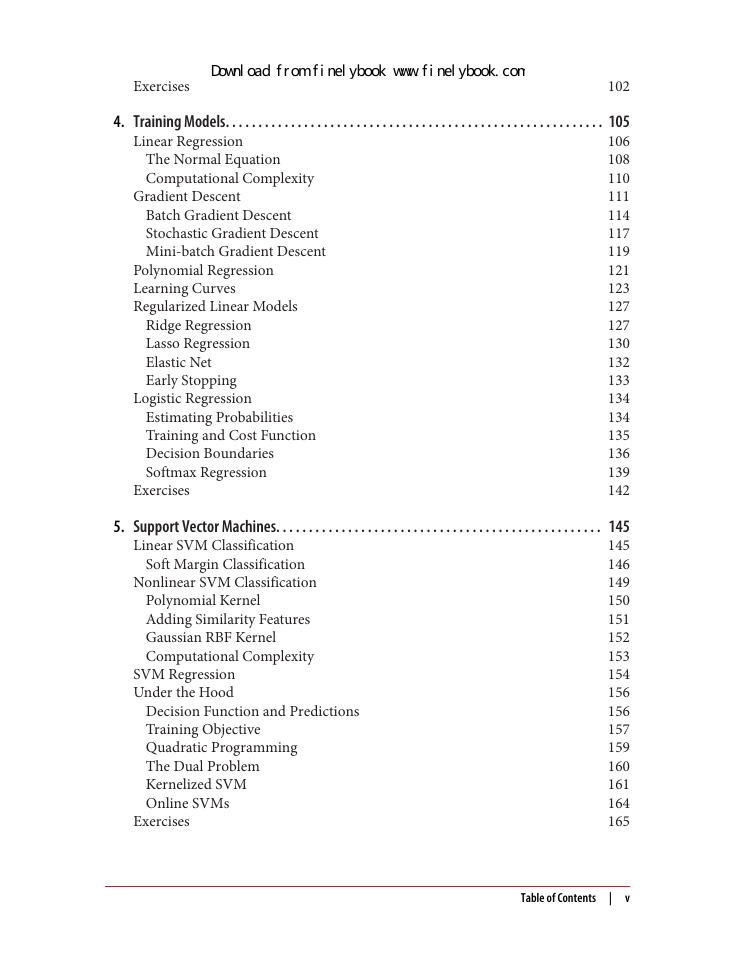









 2023年江西萍乡中考道德与法治真题及答案.doc
2023年江西萍乡中考道德与法治真题及答案.doc 2012年重庆南川中考生物真题及答案.doc
2012年重庆南川中考生物真题及答案.doc 2013年江西师范大学地理学综合及文艺理论基础考研真题.doc
2013年江西师范大学地理学综合及文艺理论基础考研真题.doc 2020年四川甘孜小升初语文真题及答案I卷.doc
2020年四川甘孜小升初语文真题及答案I卷.doc 2020年注册岩土工程师专业基础考试真题及答案.doc
2020年注册岩土工程师专业基础考试真题及答案.doc 2023-2024学年福建省厦门市九年级上学期数学月考试题及答案.doc
2023-2024学年福建省厦门市九年级上学期数学月考试题及答案.doc 2021-2022学年辽宁省沈阳市大东区九年级上学期语文期末试题及答案.doc
2021-2022学年辽宁省沈阳市大东区九年级上学期语文期末试题及答案.doc 2022-2023学年北京东城区初三第一学期物理期末试卷及答案.doc
2022-2023学年北京东城区初三第一学期物理期末试卷及答案.doc 2018上半年江西教师资格初中地理学科知识与教学能力真题及答案.doc
2018上半年江西教师资格初中地理学科知识与教学能力真题及答案.doc 2012年河北国家公务员申论考试真题及答案-省级.doc
2012年河北国家公务员申论考试真题及答案-省级.doc 2020-2021学年江苏省扬州市江都区邵樊片九年级上学期数学第一次质量检测试题及答案.doc
2020-2021学年江苏省扬州市江都区邵樊片九年级上学期数学第一次质量检测试题及答案.doc 2022下半年黑龙江教师资格证中学综合素质真题及答案.doc
2022下半年黑龙江教师资格证中学综合素质真题及答案.doc